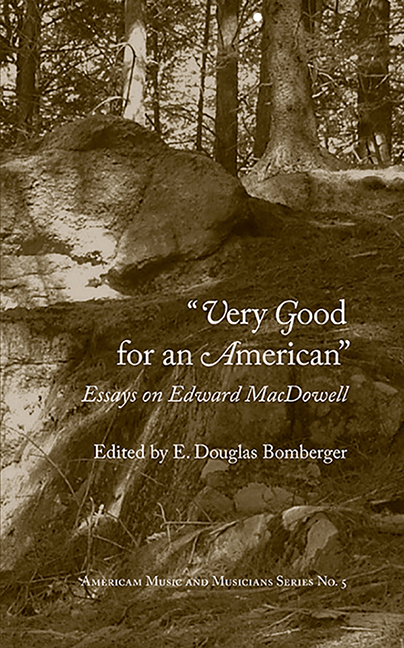Book contents
- Frontmatter
- Table of Contents
- Illustrations
- Contributors
- Acknowledgments
- Introduction: MacDowell at 150
- Edward MacDowell and the Society of Friends
- Historical Concerts in New York City, 1860-1876: An Approximation
- “No MacDowell, No Carreño”: Teresa Carreño's Contributions to the Dissemination of Edward MacDowell's Piano Music
- MacDowell, Liszt, and the Symphonic Tone Poem
- Wagnerian Influence and Motives in the Works of Edward MacDowell
- “On Sundays there was the music …” George Whitefield Chadwick between symphony and organ
- MacDowell vs. Butler: The “Idealist” Professor and the Administrator of “Materialism”
- Parallels in the Careers of Edward A. MacDowell and Chou Wen-chung
- American Bayreuth: The 1910 Peterborough Pageant and the Genesis of the MacDowell Colony
- Selective Bibliography
- Index
Wagnerian Influence and Motives in the Works of Edward MacDowell
- Frontmatter
- Table of Contents
- Illustrations
- Contributors
- Acknowledgments
- Introduction: MacDowell at 150
- Edward MacDowell and the Society of Friends
- Historical Concerts in New York City, 1860-1876: An Approximation
- “No MacDowell, No Carreño”: Teresa Carreño's Contributions to the Dissemination of Edward MacDowell's Piano Music
- MacDowell, Liszt, and the Symphonic Tone Poem
- Wagnerian Influence and Motives in the Works of Edward MacDowell
- “On Sundays there was the music …” George Whitefield Chadwick between symphony and organ
- MacDowell vs. Butler: The “Idealist” Professor and the Administrator of “Materialism”
- Parallels in the Careers of Edward A. MacDowell and Chou Wen-chung
- American Bayreuth: The 1910 Peterborough Pageant and the Genesis of the MacDowell Colony
- Selective Bibliography
- Index
Summary
That MacDowell knew Richard Wagner's compositions intimately and admired his achievement is shown by references made to specific works in his Critical and Historical Essays and in the musical material he incorporated into his own compositions. In his essay “Declamation in Music,” he offered a concise analysis of Wagner's accomplishment:
The vital principle of Wagner's art was that he not only made startlingly vivid pictures in his music, but that he made the people in these pictures actually walk out of the frame and directly address the audience…. his orchestra forms a kind of pictorial and psychological background from which his characters detach themselves and actually speak. If they speak falsely, the ever present orchestra … unmercifully tears away the mask …
Reading MacDowell's words some time ago awakened me to the possibility of connections and sent me in search of evidence. This article identifies for the first time passages in which there are actual musical quotations and points to other areas where Wagner's music is suggested. In the compositions with recognizable motives, Mac- Dowell usually treats the first statements as quotations or paraphrases, subsequently using the small idea as the basis for a passage whose origins are submerged in the total musical fabric.
In addition to the direct quotations, MacDowell seems to have absorbed some general features of Wagner's style:
Melodies are constructed of motives, not necessarily tuneful, creating melodic areas of a declamatory rather than lyrical nature, described by Rey M. Longyear as a: “Less ‘melodic’ but highly significant … type of instrumental melodic writing that is abstract and motivic rather than tuneful and phraseoriented; … The most striking continuations of this kind of abstract design, as opposed to tune, are to be found as leitmotives in Wagner's … music dramas.”
At times, harmony emanates from the polyphonic fabric of related motives or tonal cells.
Shifting sonorities, generated at points of expressive intensity, are often altered chords, and upper-partial chords or sevenths, frequently favoring the half-diminished seventh chord, at times dissolving into areas of non-functional harmony. For MacDowell, entire sections might be said to grow from exploration of a single harmony.
- Type
- Chapter
- Information
- Very Good for an AmericanEssays on Edward MacDowell, pp. 105 - 128Publisher: Boydell & BrewerPrint publication year: 2017

